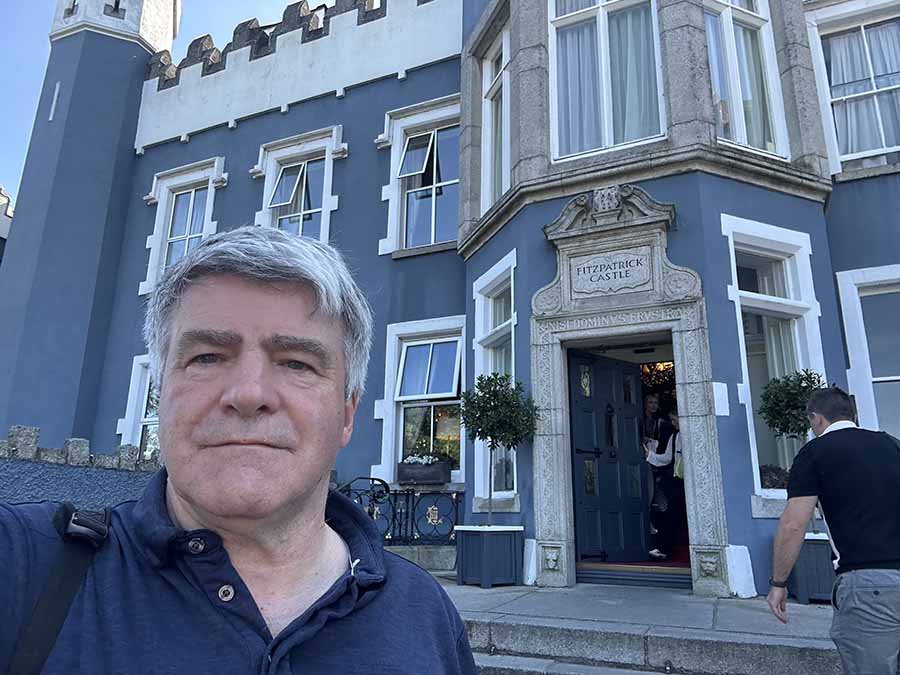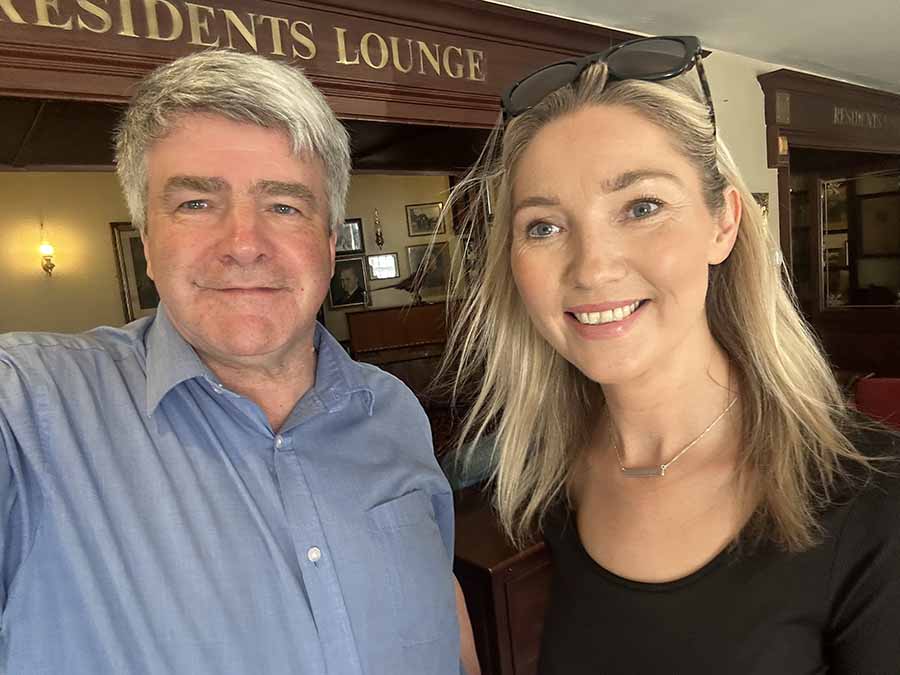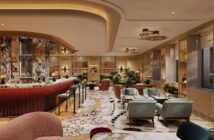
The setting is familiar to anyone who has passed on the train, the iconic seascape of Killiney Hill and sweeping views over Dublin Bay. Fitzpatrick’s Castle Hotel is halfway up that hill. We decided, for research purposes, to hike up from the station, Killiney station which is further form the hotel than Dalkey, on the hottest day so far of the summer, and found out as much.
The story too, is familiar. It was opened in in 1971 by the grandfather of the current owners, an 18th-century manor house and faux castle turned into a four-star family-owned hotel, a cornerstone of hospitality in south Dublin for five decades, with the Fitzpatrick family at its helm since the 1970s. It has proven a firm favourite with the American market. During our stay the accents were ubiquitous.
Visitors to Fitzpatrick’s Castle Hotel can expect a warm welcome rooted in the family’s tradition of hospitality. The 113 rooms, ranging from classic castle-style chambers to modern suites with sea views, offer comfort with amenities like free Wi-Fi, in-room entertainment, and spacious bathrooms.
Our room, 421, came with its own sitting room suite and a view back to Dun Laoghaire harbour and across the bay to Howth Hill, giving a sense of royalty in the days of the Viking era when the House of Dunchada ruled their kingdom of south Dublin and north Kildare from here. Thin legged tables and chairs with S bends give a period Chippendale or Queen Anee feel in keeping with the castle architecture, yellows and beiges convey that sense that the world is at ease with itself, helped along by the sunshine flooding the room form the windows and the long balcony (two chairs and table for siping romantic drinks). The lobby is labyrinthine (a sing on the lift helpfully informs you there is another one around the corner and a hop, skip and jump away). You can see why Americans would love this place.
The building, originally constructed in 1740 by Colonel John Malpas as Mount Malpas, has undergone transformations over the centuries. By 1755, it passed to Captain Maunsell, followed by Colonel Loftus, who enhanced the estate with landscaped gardens and a carriage road around Killiney Hill. In 1840, Robert Warren acquired the property, adding castellations, turrets, and battlements to create the castle-like appearance seen today, renaming it Killiney Castle.
After periods of abandonment and use by the Irish Army during the 1930s and 1940s, Paddy and Eithne Fitzpatrick transformed the estate into a hotel in 1971. Now in its third generation of family ownership, the hotel is managed by Eithne Scott-Lennon’s sons, Mark and Joseph Scott-Lennon, who recently expanded the family’s portfolio with the acquisition of the Woodenbridge Hotel and Lodge in Wicklow.
Dining options include PJ’s Restaurant, known for its locally sourced Irish cuisine, and the Dungeon Bar & Grill, set in the former castle dungeon, where guests can enjoy casual meals by a fireplace. The Library Bar serves afternoon tea, a favourite among locals and visitors alike. Leisure facilities feature a 20-metre indoor pool, sauna, steam room, and a well-equipped gym, while the surrounding grounds invite exploration of Killiney Hill Park, just steps away, or nearby Dalkey Village.
Walk down, but take a taxi home.



The flagship hotel of the Fitzpatrick Hotel Group in Killiney, south Dublin, an 18th-century manor house transformed into a luxury hotel, is recognised as an icon of the Irish hospitality industry.
- 1740: Killiney Castle, originally named Mount Malpas, was built by Colonel John Mapas. The site, located near Killiney Hill with views over Dublin Bay, had earlier historical significance, with records suggesting occupation as early as the 13th century under the Talbots of Malahide.
- 1755–1770: The estate was acquired by Captain Maunsell, followed by Colonel Henry Loftus, who enhanced the property with a new carriage road and extensive landscaping, including fruit trees and flowers.
- 1840: Robert Warren, a solicitor and developer, purchased the estate, renaming it Killiney Castle. He added Gothic architectural features like castellations, turrets, and a porch, and contributed to local infrastructure, including funding for the Killiney parish church and influencing the Dublin-Bray railway line.
- 1871: Financial difficulties forced Warren to auction parts of the estate, with Victoria Hill named in honor of Queen Victoria’s Jubilee Memorial Association.
- 1870s–1880s: The castle changed hands multiple times, including ownership by the Jesuit Order (1877–1880) as a holiday house and later by Thomas Chippendall Higgin, who added further architectural enhancements.
- 20th Century (Pre-1970s): The castle saw turbulent times, used by the Black and Tans, IRA, Republicans, and Free State Troops during the Irish Civil War, and was requisitioned as army billets during World War II (1939–1945). It reportedly fell into disrepair during parts of this period.
- 1971: Paddy Fitzpatrick and his wife Eithne Fitzpatrick purchased Killiney Castle and transformed it into the Fitzpatrick Castle Hotel, opening it as a luxury hotel. This marked the beginning of the Fitzpatrick Hotel Group’s legacy in Killiney. Paddy, an experienced hotelier, while Eithne, a former Miss Ireland, was instrumental in the hotel’s interior design and hospitality vision.
- 1970s–1980s: The Fitzpatricks established the hotel as a premier destination, blending the castle’s historical charm with modern amenities. Their focus on personalized service and elegance made it a leading venue for weddings, business, and leisure. Paddy and Eithne expanded the Fitzpatrick Hotel Group beyond Killiney, acquiring the Fitzpatrick Shamrock Hotel in Bunratty, County Clare, and the Fitzpatrick Silver Springs in Cork.
- 2002: Following Paddy’s passing, After Paddy’s passing, his daughter Eithne Fitzpatrick Scott-Lennon assumed leadership and managed the hotel until 2023.
- 1991: John Fitzpatrick, the second eldest of Paddy and Eithne’s five children, established the Fitzpatrick Hotel Group in New York. After gaining experience in the U.S., he opened the Fitzpatrick Manhattan Hotel in December 1991, followed by the Fitzpatrick Grand Central a few years later. These hotels catered to high-profile guests, including heads of state and celebrities, and became known for their Irish hospitality. John’s work was influenced by his parents’ legacy, and he later became a prominent philanthropist, raising funds for Irish charities.
- 2024: The Fitzpatrick Hotel Group, under the leadership of Eithne’s sons, Mark and Joseph Scott-Lennon, acquired the Woodenbridge Hotel and Lodge in Wicklow, Ireland’s oldest hotel (est. 1604). This marked the first significant expansion in 20 years, adding to the family’s portfolio.
- Third-Generation Leadership and Recent Developments2023: Eithne Fitzpatrick Scott-Lennon retired as Owner/CEO, passing leadership to her sons, Mark Scott-Lennon (Managing Director) and Joseph Scott-Lennon (Hotel Manager), marking the third generation of family ownership. They announced a €10 million investment plan over five years for property enhancements, sustainability, and expansion.
- 2024: The hotel celebrated its 50th anniversary (from its 1971 opening as a hotel) with a transformation, including a redesigned logo, new spaces like The Terrace at the Castle, and sustainability initiatives such as participation in the Clean the World program.
- April 2024: A temporary setback occurred when three kitchens (Albert & Behan, PJ’s, and Mapas) were issued a closure order by the Food Safety Authority of Ireland due to hygiene issues, including rodent droppings. The order was lifted two days later on April 17, 2024, after compliance was achieved.
- August 2024: The hotel reported an 18% increase in operating profits to €535,830, reflecting strong financial recovery post-COVID-19, during which the hotel remained open to support staff and the local community.



